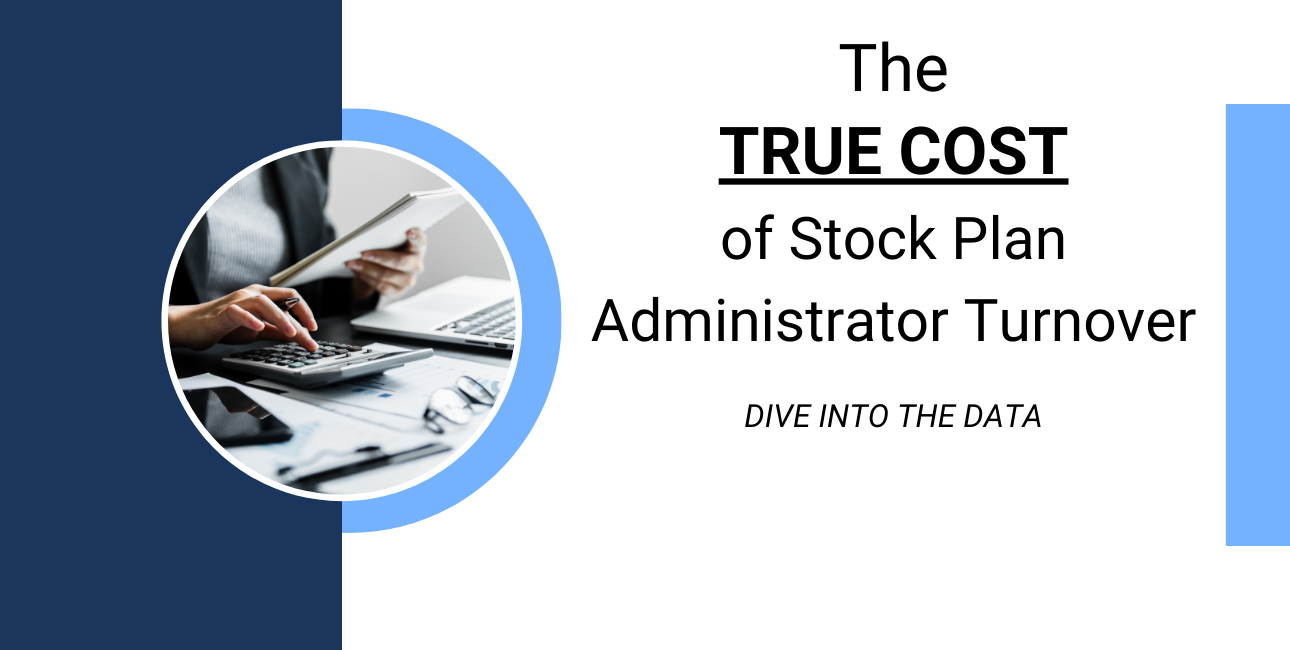
Two hundred ninety-eight thousand dollars.
When businesses experience stock plan administrator turnover, this is what they are potentially losing when one leaves the company.
How did we come to this conclusion?
Based on Salary.com data, a Senior Stock Plan Administrator earns a national, 75% percentile, base salary of $149,000 per year. And according to Gallup, the cost of replacing an individual employee can range from one-half to two times the employee’s annual salary – and that’s a conservative estimate.
$149,000 (median base salary) * 2 (multiplier) = $298,000 (total cost to employer)
At a bare minimum, companies are estimated to lose $74,500 per year.
$149,000 (median base salary) * 50% (multiplier) = $74,500 (total cost to employer)
Breaking down turnover costs
Managers instinctively sense the pain of the departure, the negative cultural ramifications, or even the painful gap left behind who was doing important work. But losing a highly technical stock plan professional can have a big impact on your organization’s bottom line.
The problem is managers tend to optimize what they can measure, rather than see the full picture of the impact. Losing your stock plan administrator is generally understood to be bad, but there is little awareness of the full quantifiable impact.
So, let’s consider both the hard and soft costs of this loss.
Recruitment costs
Advertising, company website updates, social media announcements, recruitment agencies, interviewing, screening, and hiring
Onboarding and training
Orientation programs, training materials, hardware, and software access.
Administrative processing
Resignation notice, exit interviews, updating employee’s records, calculating final paycheck, return of company property, benefits termination, exit documentation, and final communication to the employee and company.
Interviewing candidates
The time set aside by human resources and managers to prepare interview questions, attend interviews, evaluation, and offer.
Lower productivity
Transition period may include increased errors, missed deadlines, and supervisors spending time to cover the equity compensation administration.
Lower company engagement and morale
Remaining teammates may feel a sense of loss, increased workload, or decreased morale.
What Should Managers Do?
The cost of stock plan administrator turnover can be substantial, both in terms of financial and non-financial factors. Businesses must have contingency plans in place to prepare for a continuous, stable stock plan department. Here’s a general framework for the short and long-term.
Think Critically About the Short-Term
Managers should set specific goals, objectives, and strategies for the near future, usually within a timeframe of one month to a year. The process involves current market conditions, resources, and limitations to develop a plan of action that addresses immediate needs and priorities.
Key items to address:
- Assess why the stock plan administrator might leave.
- Do we have a hiring plan in place if the stock plan administrator leaves?
- Who takes the workload in the interim?
The purpose should be to outline the steps and activities required to absorb the current workload and fill any immediate gaps.
Plan for the Long-Term
Long-term planning should be a systematic and comprehensive process the stock plan department must undertake based on long-term goals and objectives, actions and resources needed, and a roadmap for sustainable administration. The process involves analyzing the current internal and external environment, setting a direction for the department, and making decisions that align with the overall company’s objectives.
Key items to address:
- What is the total cost to the business if we hire in-house?
- Is this a function we want to manage in-house?
- Do you have the right structure in place?
Creating a structured approach will help navigate complexity, set priorities, and allocate resources efficiently to achieve long-term success. Success is realized when accounting/finance, human resources, and legal align, but more importantly, allow each department to focus on their core priorities.
At Stock & Option Solutions, our team helps with interim placement, long-term consultants, and full outsourcing to help you navigate from short-term needs to a long-term, sustainable department.
Contact us for your no-obligation consultation to see if outsourcing is right for you.
Follow us:

